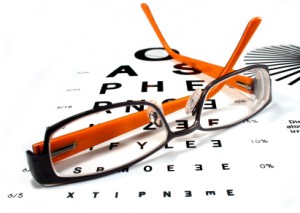The Necessity for Glasses in Order to See Clearly From a Distance
Myopia is a condition in which a healthy eye is slightly, up to a few millimeters, larger than a standard sized eye. As a result, the eye is not in focus, the image that one views, does not fall precisely on the retina and it is necessary to wear glasses (or contact lenses), in order to correct the focus and enable clear vision.
One may ask: Why is a myopic eye larger than a standard size eye?
The answer is that not all people have eyes that are exactly the same size, much like the fact that not all people are the same height, wear the same shoe size, or are exactly identical in their shape. When the difference is in shoe size, one simply fits the shoe according to the size of the foot. Similarly, different sized eyes require fitting different prescription glasses in order to allow a sharp picture to fall on the retina.
What, beyond the necessity for wearing glasses, is the medical significance of having myopia?
The answer is that in a myopic eye, particularly if the myopia is of high magnitude (for example, greater than minus 6), other problems related to the health of the eye may arise. The retina tends to be thinner at the periphery in large eyes and thus, slow degenerative changes, which are not troublesome on a day to day basis, may appear. These changes may weaken the retina and therefore slightly increase the likelihood of holes or tears appearing at some point in one’s lifetime. Such holes and tears increase the risk for retinal detachment, a complex condition which requires immediate surgical management.
Additional problems in myopic eyes (again referring to severely myopic eyes as mentioned above) are associated with cataracts appearing at a slightly younger age. A glaucomatous eye that has myopia may progress slightly faster than a similar glaucomatous eye that does not have myopia.
Myopia is a very common condition. Up to one third of the population has a significant minus number prescription glasses. Thus, it is intuitive to understand that the risks associated with myopic eyes, such as holes and tears in the retina, appear in only a very low percentage of myopic eyes. One needs to be slightly more careful in caring for the health of his/her myopic eyes, usually in the form of a yearly eye examination, or more frequently if your ophthalmologist suggests so.
I will briefly describe the significance of glasses in myopic eyes. A regular eye is approximately 24mm in size, approximately the size of a ping-pong ball. Myopic eyes are, in actuality, only approximately one or two millimeters bigger than a regular eye. In other words, instead of the eye being 24 mm it may be 26mm, for instance. These two millimeters of added length, which to us may seem rather insignificant, have a key effect on the focus of an image on the retina, and express themselves as the need for glasses with a prescription of minus 6 diopters (-6.00D). The basic equation is that for every millimeter added to the length of the eye, the prescription number of the glasses changes by another minus 3 diopters.
Myopic eyes cannot see clearly objects that are at a distance. A myopic person can see close by objects very well, often better than a regular eye. However, in order to see clearly from a distance they require glasses, and are therefore called: nearsighted. It is important to emphasize that there is one small advantage to people who are nearsighted – it is possible that they will not need reading glasses when they reach 40-50 years of age, whereas people with regular eyes will always eventually require reading glasses.
In order to read things that are close, a myopic person removes his glasses and thus “corrects” his vision. In cases in which people happen to be very myopic, they may have a tendency to slide their glasses to the tip of their nose, a maneuver which allows them to “change” the power of their glasses, thus improving their vision for near.
During puberty, a myopic eye will continue growing beyond the size of a normal eye (beyond 24mm). As a result, blurry vision for distant objects develops and glasses become a necessity. At this point the person is nearsighted, implying that he/she sees objects that are close by in good focus, while distant objects appear very blurry without the help of glasses.
A typical eye continues to grow throughout childhood and puberty until the age of around 18-20, at which point the entire body ceases to grow. Therefore, it is in this time period that frequent changes in the prescription of one’s glasses are needed, usually a new pair every year of two. After the age of 20 the prescription (the power of the lenses in one’s glasses) generally remains more or less stable. It is possible that small changes, in the order of half a diopter or so may later develop.
Of note, at around the ages of 60-70 it again becomes necessary to change the prescription of glasses very often, but this change is not the result of growth or shrinkage of the eye. Rather, it is the result of optic changes in the lens, which essentially represent changes associated with developing cataracts. At this time, the number of the prescription changes and occasionally require adjustment every year or two (and at times even twice a year) until a point is reached at which changing the refraction is no longer effective in correcting the blurred vision created by the cataract. When this point is reached, it is recommended to consider undergoing cataract surgery in order to remove the opaque cataract in the affected eye.
In summary: Myopia is a condition in which the eyeball is slightly larger than average and therefore the image that the eye sees does not fall precisely on the retina. In order to correct the focus, a person must wear glasses with a minus number, which now allows for proper focusing of the image on the retina. At least one third of the adult population suffers from some degree of myopia, making this the most common visual disturbance.


